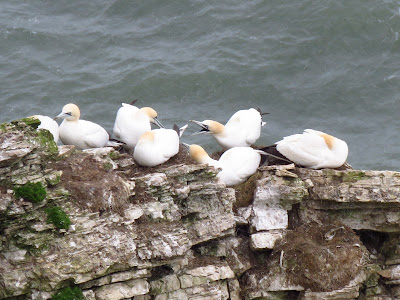Despite the forecast of very cold easterlies and snow I headed to the coast this morning. I stopped at Bridlington Harbour and walked the north and south piers. I could see a single Purple Sandpiper, but there were plenty of Redshank and Dunlin on the exposed and sheltered mud of the harbour, and an immature Great Black-backed gull feeding on a large fish. The Barnacle Geese still present in the harbour. The waves crashed against the north pier and the tide was rising so I decided to move onto Bempton Cliffs.
Immature Great Black-backed gull with breakfast.
Purple Sandpiper.
Purple Sandpiper.
Herring Gull pair.
Dunlin.
Another pair Herring gull braving the wind on the north pier.
Snow flurries greeted me at Bempton. It was sheltered at some spots, and exposed at others. Gannets circling and on nests and Fulmars squabbling and displaying were plentiful at the cliffs. No Kittiwakes or auks at all to be seen.
Just after getting to Jubilee Corner a pair of Peregrines appeared. What looked like the tiercel displayed by diving in front of the falcon and towards gannets or fulmars. They circled almost above me for a while before flying towards the fields. The photos today were poor as the wind and the dark conditions didn't help.
Gannets.
Gannet.
Feral Pigeons.
Circling Fulmars.
Fulmar on nest.
Pair of Peregrines.
Snow showers coming from the sea.
Staple Newk.
Shags.
Gannets.
Kestrel. One of ten I spot on the trip today.
Kestrels on the trip today.



































































